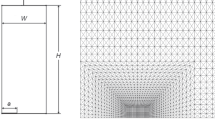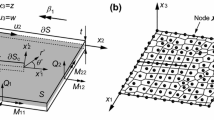Abstract
A high-order extended finite element method based on the spectral element method for the simulation of dynamic fracture is developed. The partition of unity for the discontinuous displacement is constructed by employing p order spectral element. This method shows great advantages in the simulations of moving crack and mixed mode crack. The numerical oscillations are effectively suppressed and the accuracy of computed stress intensity factors and crack path are improved markedly. Furthermore the simulation results show that p-refinement is more effective in improving the stress contour near the crack tip than h-refinement. The well known form of the explicit central difference method is used and the critical time step for this method is investigated. We find that by using lumped mass matrix the critical time step Δt c for this high-order extended finite element is almost independent of the crack position.
Similar content being viewed by others
References
Areias P, Belytschko T (2005) Analysis of three-dimensional crack initiation and propagation using the extended finite element method. Int J Numer Meth Eng 63: 760–788
Attigui M, Petit C (1997) Mixed-mode separation in dynamic fracture mechanics: new path independent integrals. Int J Fract 84: 19–36
Belytschko T, Black T (1999) Elastic crack growth in finite elements with minimal remeshing. Int J Numer Meth Eng 45: 601–620
Belytschko T, Chen H, Xu J, Zi G (2003) Dynamic crack propagation based on loss of hyperbolicity and a new discontinuous enrichment. Int J Numer Meth Eng 58: 1873–1905
Belytschko T, Liu W, Moran B (2000) Nonlinear finite elements for continua and structures. Wiley, New York
Böhme W, Kalthoff J (1982) The behavior of notched bend specimens in impact testing. Int J Fract 20: 139–143
Capdeville Y, Chaljub E, Vilotte J, Montagner J (2003) Coupling the spectral element method with a modal solution for elastic wave propagation in global Earth models. Geophys J Int 152: 34–67
Chessa J, Wang H, Belytschko T (2003) On the construction of blending elements for local partition of unity enriched finite elements. Int J Numer Meth Eng 57: 1015–1038
Duan Q, Song J, Menouillard T, Belytschko T (2009) Element-local level set method for three-dimensional dynamic crack growth. Int J Numer Meth Eng 80: 1520–1543
Elguedj T, Gravouil A, Maigre H (2009) An explicit dynamics extended finite element method. Part 1: mass lumping for arbitrary enrichment functions. Comput Meth Appl Mech Eng 198: 2297–2317
Fish J, Belytschko T (1990) A finite element with a unidirectionally enriched strain field for localization analysis. Comput Meth Appl Mech Eng 78: 181–200
Fleming M, Chu Y, Moran B, Belytschko T, Lu Y, Gu L (1997) Enriched element-free Galerkin methods for crack tip fields. Int J Numer Meth Eng 40: 1483–1504
Freund L (1990) Dynamic fracture mechanics. Cambridge University Press, Cambridge
Freund L, Douglas A (1982) The influence of inertia on elastic-plastic antiplane-shear crack growth. J Mech Phys Solids 30: 59–74
Hansbo A, Hansbo P (2004) A finite element method for the simulation of strong and weak discontinuities in solid mechanics. Comput Meth Appl Mech Eng 193: 3523–3540
Kalthoff J (1985) On the measurement of dynamic fracture toughnesses-areview of recent work. Int J Fract 27: 277–298
Karniadakis G, Sherwin S (1999) Spectral/hp element methods for CFD. Oxford University Press, USA
Komatitsch D, Tromp J (1999) Introduction to the spectral element method for three-dimensional seismic wave propagation. Geophys J Int 139: 806–822
Komatitsch D, Vilotte J (1998) The spectral element method: an efficient tool to simulate the seismic response of 2D and 3D geological structures. Bull Seismol Soc Am 88: 368–392
Krysl P, Belytschko T (1999) The element free Galerkin method for dynamic propagation of arbitrary 3-D cracks. Int J Numer Meth Eng 44: 767–800
Lee Y, Freund L. (1990) Fracture initiation due to asymmetric impact loading of an edge cracked plate. J Appl Mech 57: 104–111
Legay A, Wang H, Belytschko T (2005) Strong and weak arbitrary discontinuities in spectral finite elements. Int J Numer Meth Eng 64: 991–1008
Melenk J, Babuška I (1996) The partition of unity finite element method: basic theory and applications. Comput Meth Appl Mech Eng 139: 289–314
Menouillard T, Belytschko T (2009) Correction Force for releasing crack tip element with XFEM and only discontinuous enrichment. Eur J Comput Mech 18: 465–483
Menouillard T, Belytschko T (2010) Dynamic fracture with meshfree enriched XFEM. Acta Mech 213: 53–69
Menouillard T, Réthoré J, Combescure A, Bung H (2006) Efficient explicit time stepping for the extended finite element method (X-FEM). Int J Numer Meth Eng 68: 911–939
Menouillard T, Réthoré J, Moës N, Combescure A, Bung H (2008) Mass lumping strategies for X-FEM explicit dynamics: application to crack propagation. Int J Numer Meth Eng 74: 447–474
Menouillard T, Song J, Duan Q, Belytschko T (2010) Time dependent crack tip enrichment for dynamic crack propagation. Int J Fract 162: 33–49
Mercerat E, Vilotte J, Sanchez-Sesma F (2006) Triangular spectral element simulation of two-dimensional elastic wave propagation using unstructured triangular grids. Geophys J Int 166: 679–698
Moës N, Dolbow J, Belytschko T (1999) A finite element method for crack growth without remeshing. Int J Numer Meth Eng 46: 131–150
Padovani E, Priolo E, Seriani G (1994) Low-and high-order finite element method: experience in seismic modeling. J Comput Acoust 2: 371–422
Patera A (1984) A spectral element method for fluid dynamics: laminar flow in a channel expansion. J Comput Phys 54: 468–488
Ravi-Chandar K (2004) Dynamic fracture. Elsevier, Amsterdam
Réthoré J, Gravouil A, Combescure A (2005) An energy-conserving scheme for dynamic crack growth using the extended finite element method. Int J Numer Meth Eng 63: 631–659
Rice J (1968) A path independent integral and the approximate analysis of strain concentration by notches and cracks. J Appl Mech 35: 379–386
Rosakis A, Freund L (1982) Optical measurement of the plastic strain concentration at a crack tip in a ductile steel plate. J Eng Mater Technol 104: 115
Seriani G, Oliveira S (2007) Dispersion analysis of spectral element methods for elastic wave propagation. Wave Motion 45: 729–744
Song J, Areias P, Belytschko T (2006) A method for dynamic crack and shear band propagation with phantom nodes. Int J Numer Meth Eng 67: 863–893
Song J, Belytschko T (2009) Dynamic fracture of shells subjected to impulsive loads. J Appl Mech 76: 051301
Author information
Authors and Affiliations
Corresponding author
Rights and permissions
About this article
Cite this article
Liu, Z.L., Menouillard, T. & Belytschko, T. An XFEM/Spectral element method for dynamic crack propagation. Int J Fract 169, 183–198 (2011). https://doi.org/10.1007/s10704-011-9593-y
Received:
Accepted:
Published:
Issue Date:
DOI: https://doi.org/10.1007/s10704-011-9593-y




